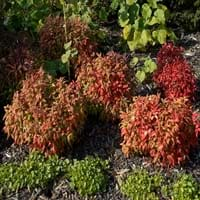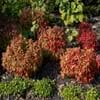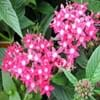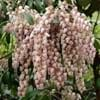Life Span
Perennial
Perennial
Type
Broadleaf Evergreen
Bulb or Corm or Tuber
Origin
China, Japan
South America, Argentina
Types
Heavenly Bamboo, Nandina 'Colerno'
Dwarf Nandina 'Compacta'
Dwarf Nandina 'Filamentosa'
Heavenly Bamboo, Nandina 'Harbor Belle'
Heavenly Bamboo, Nandina 'Moon Bay'
Not Available
Number of Varieties
Not Available
Habitat
low mountains, Mountain tops, Mountains, Valley
Temperate Regions
USDA Hardiness Zone
6-11
5-9
AHS Heat Zone
Not Available
9-1
Habit
Clump-Forming
Clump-Forming
Flower Color
Not Available
Light Blue, Light Purple, Silver, Sky Blue
Flower Color Modifier
Bicolor
Bicolor
Fruit Color
Not Available
Not Available
Leaf Color in Spring
Green, Purple, Copper
Green, Light Green, Gray Green
Leaf Color in Summer
Green, Purple
Light Green
Leaf Color in Fall
Green, Purple
Several shades of Green
Leaf Color in Winter
Red, Green, Purple
Light Green
Leaf Shape
Acuminate
Grass like
Plant Season
Spring, Summer, Fall, Winter
Spring
Sunlight
Full Sun, Partial Sun, Partial shade, Full Shade
Full Sun, Partial Sun, Partial shade
Growth Rate
Medium
Medium
Type of Soil
Loam, Sand
Clay, Loam, Sand
The pH of Soil
Acidic, Neutral, Alkaline
Acidic, Neutral, Alkaline
Soil Drainage
Well drained
Well drained
Bloom Time
Not Available
Early Spring, Spring, Late Winter
Tolerances
Drought
Drought
Where to Plant?
Ground
Container, Ground
How to Plant?
Seedlings
By dividing rhizomes, tubers
Plant Maintenance
Medium
Medium
Watering Requirements
Do not water frequently, Needs less watering
Average Water Needs, Do Not over Water, Requires regular watering
In Summer
Lots of watering
Lots of watering
In Spring
Moderate
Moderate
In Winter
Average Water
Average Water
Soil pH
Acidic, Neutral, Alkaline
Acidic, Neutral, Alkaline
Soil Type
Loam, Sand
Clay, Loam, Sand
Soil Drainage Capacity
Well drained
Well drained
Sun Exposure
Full Sun, Partial Sun, Partial shade, Full Shade
Full Sun, Partial Sun, Partial shade
Pruning
Remove damaged leaves, Remove dead branches, Remove dead leaves
Remove damaged leaves, Remove dead branches, Remove dead leaves
Fertilizers
All-Purpose Liquid Fertilizer
All-Purpose Liquid Fertilizer
Pests and Diseases
Red blotch
Slugs, Snails
Plant Tolerance
Drought
Drought
Flower Petal Number
Not Available
Single
Foliage Texture
Fine
Medium
Foliage Sheen
Glossy
Matte
Attracts
Mealybugs, Whiteflies
Bees, Birds, Hummingbirds
Allergy
Not Available
Not Available
Aesthetic Uses
Bonsai, Borders
Showy Purposes
Beauty Benefits
Not Available
Not Available
Environmental Uses
Air purification
Air purification
Medicinal Uses
Antirheumatic, Antitussive, Astringent
No Medicinal Use
Part of Plant Used
Fruits, Leaves
Flowers
Other Uses
Used for making informal hedge
Not Available
Used As Indoor Plant
No
Yes
Used As Outdoor Plant
Yes
Yes
Garden Design
Container, Edging, Foundation, Groundcover, Hedges, Mixed Border, Topiary, Bonsai, Espalier
Container, Lawns and Turf, Mixed Border, Rock Garden / Wall, Wildflower
Botanical Name
NANDINA domestica 'Nana Purpurea'
Ipheion uniflorum
Common Name
heavenly bamboo
sacred bamboo
nandina
Spring Starflower, Springstar
In Hindi
Dwarf Nandina
Spring Starflower
In German
Dwarf Nandina
Frühling Borretsch
In French
Nandina Dwarf
Spring Starflower
In Spanish
Nandina enana
primavera Flor de estrella
In Greek
Dwarf Nandina
άνοιξη starflower
In Portuguese
Nandina do anão
primavera Starflower
In Polish
Dwarf Nandina
Wiosna Starflower
In Latin
Dwarf Nandina
Spring Starflower
Phylum
Tracheophyta
Magnoliophyta
Class
Magnoliopsida
Lilopsida
Order
Ranunculales
Asparagales
Family
Berberidaceae
Liliaceae
Clade
Angiosperms, Eudicots
Angiosperms, Monocots
Tribe
Not Available
Gilliesieae
Subfamily
Not Available
Allioideae
Number of Species
Not Available
Not Available
Season and Care of Dwarf Nandina and Spring Starflower
Season and care of Dwarf Nandina and Spring Starflower is important to know. While considering everything about Dwarf Nandina and Spring Starflower Care, growing season is an essential factor. Dwarf Nandina season is Spring, Summer, Fall and Winter and Spring Starflower season is Spring, Summer, Fall and Winter. The type of soil for Dwarf Nandina is Loam, Sand and for Spring Starflower is Clay, Loam, Sand while the PH of soil for Dwarf Nandina is Acidic, Neutral, Alkaline and for Spring Starflower is Acidic, Neutral, Alkaline.
Dwarf Nandina and Spring Starflower Physical Information
Dwarf Nandina and Spring Starflower physical information is very important for comparison. Dwarf Nandina height is 30.00 cm and width 60.00 cm whereas Spring Starflower height is 10.20 cm and width 5.10 cm. The color specification of Dwarf Nandina and Spring Starflower are as follows:
Dwarf Nandina flower color: Not Available
Dwarf Nandina leaf color: Green, Purple and Copper
Spring Starflower flower color: Light Blue, Light Purple, Silver and Sky Blue
- Spring Starflower leaf color: Green, Light Green and Gray Green
Care of Dwarf Nandina and Spring Starflower
Care of Dwarf Nandina and Spring Starflower include pruning, fertilizers, watering etc. Dwarf Nandina pruning is done Remove damaged leaves, Remove dead branches and Remove dead leaves and Spring Starflower pruning is done Remove damaged leaves, Remove dead branches and Remove dead leaves. In summer Dwarf Nandina needs Lots of watering and in winter, it needs Average Water. Whereas, in summer Spring Starflower needs Lots of watering and in winter, it needs Average Water.





